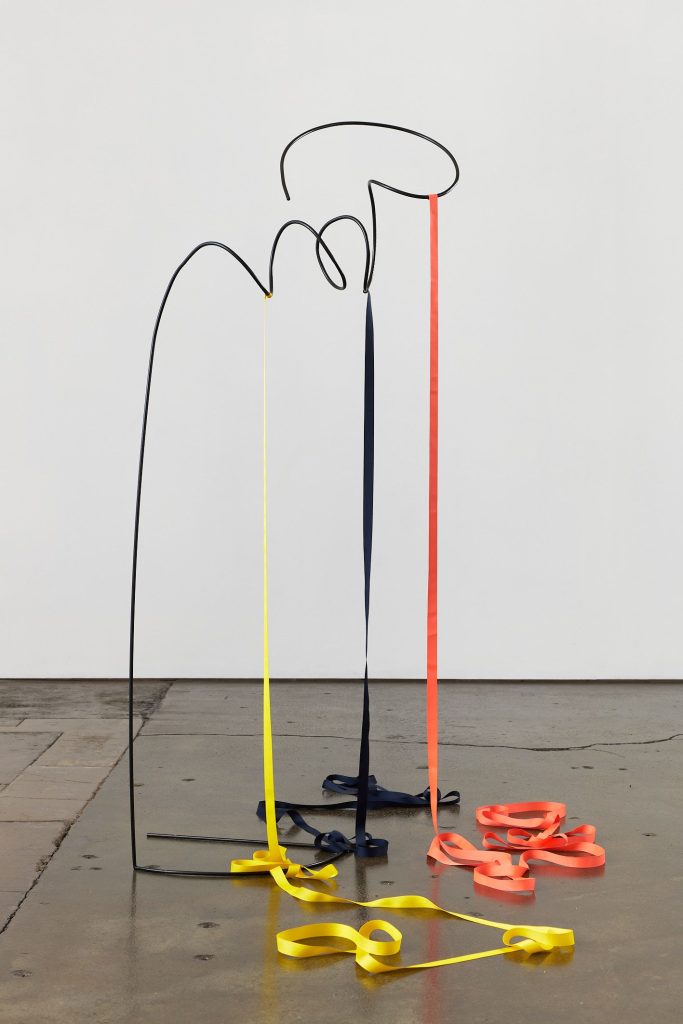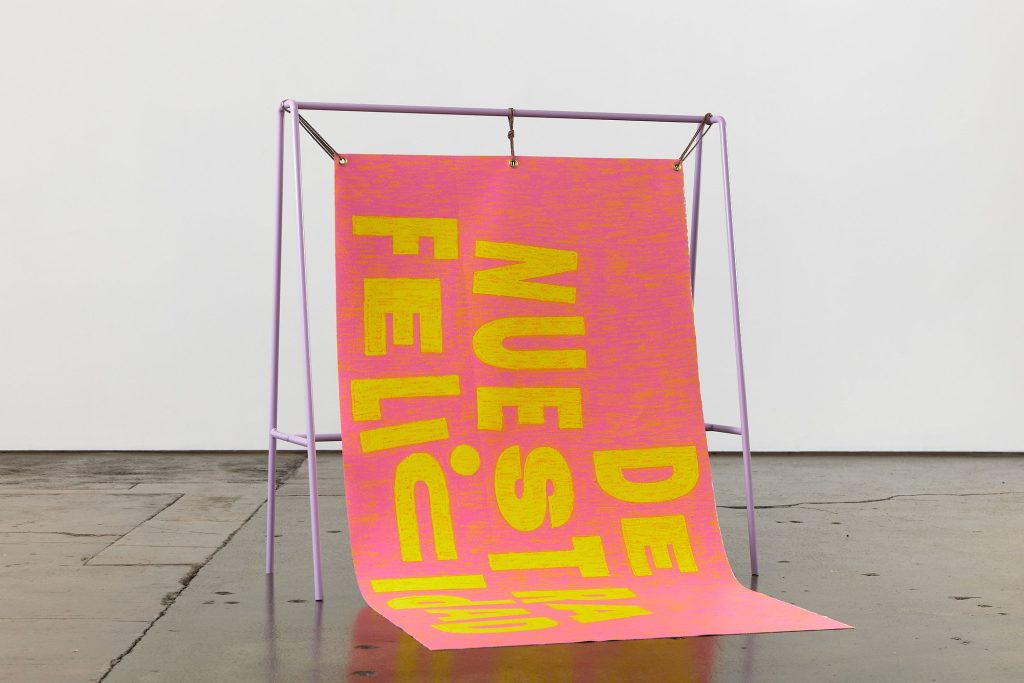With recent institutional shows at ACCA and AGWA, and an acquisition showcase at the NGV officially unveiled in October, Venezuelan-born, Melbourne-based artist Nadia Hernández is having a moment—and she’s here to stay.
By Emma Pegrum
In a cleverly converted industrial precinct alongside Merri Creek in East Brunswick, artist Nadia Hernández is busy at work. Her studio is small, but brims with energy. Scrolls of painted fabric are grouped in a corner, a collection of brightly-coloured ribbon is stacked atop a cabinet, and recent paintings— oil on linen— adorn the walls.
There are a few pieces hanging around from her work Sensibles dueños de nuestra felicidad (Sensible owners of our happiness) (2022), recently exhibited in the group show Like a Wheel That Turns: The 2022 Macfarlane Commissions at the Australian Centre for Contemporary Art (ACCA), curated by Max Delany and Annika Kristensen.
She presented a large-scale installation comprising multiple sculptural pieces that blend painting, textile and steel. Four of the works from this series are, notably, not present in the studio.
They’ve just been installed at the NGV for a new showcase, purchased through the institution’s partnership with Jo Horgan’s cosmetics empire Mecca Australia, which is focused on championing women in the arts and has a focus on those in the early stages of their careers.
As part of this, Hernández is collaborating with the Mecca design team on artwork for their store decals and packaging for the festive season. “The whole world of Mecca will be a collaboration with my artwork,” she says.
The acquisition, meanwhile, is significant not least because it is Hernández’ first from a major institution; the works themselves are ambitious in both size and scope. Assistant director of curatorial and audience engagement at the NGV, Donna McColm, says the acquisition marks an important addition to the state collection.
“The NGV has an on-going commitment to grow our collection with work by emerging contemporary female artists,” she says.
“This significant representation of Nadia’s artistic practice has a dynamic quality that will appeal to a broad audience. She is an exciting contemporary artist producing works that are full of energy, colour and optimism.

The Macfarlane commissions—as the name suggests—allow for the creation of new work, and in Hernández’ case, the development of the commission responded to the scale and dynamic shape of the building.
“I worked for about a year on those pieces, and I really challenged myself to realise them for the exhibition at ACCA,” she says. “It was an opportunity to push my practice, and to push material and concept.”
Sensibles, for example, is a 2.3 metre by 4.5 metre hanging textile piece, comprised from various fabrics hand-stitched to spell out its title in capitals—the ‘B’ is made from rope dyed with turmeric. Two other acquired pieces, Así comenzó mi procesión (dueños) (That’s how my procession started (owners) and De nuestrafelicidad (Of our happiness), are both oil and marker works on cotton—but rather than being stretched, the canvases are suspended from custom-built, standing, powder-coated steel frames (fabricated by Ben Stratton), and allowed to flow on to the ground just slightly.
The NGV’s fourth piece is Recordando al cambur politico (Remembering the political banana), a sculpture of powder-coated steel—a single, fine steel line that extends 1.8 metres directly upward from its sleek base before exploding into a spiral from which yellow, orange and navy-blue ribbons drape to the floor.


The design for this work is extracted from an earlier one, a line painting from her show Este esmi ejército (This is my army) at Sydney’s First draft in 2018. “That show was about the language of protests,” she says. “I like to create links back through my work, to reflect on the same themes with new approaches.
”The overarching title of this series—Sensibles dueños de nuestra felicidad (Sensible owners of our happiness)— is a reconfigured phrase taken from a letter Hernández’ mum wrote her when she was in the midst of moving from Sydney to Melbourne earlier this year.
It read: “In these times, it is sensible to remember that we are the owners of our happiness…remember that there is always room for moments of joy, which we must treasure…moments that nurture the spirit and give meaning to the day.”
For Hernández, who was born in Merida, Venezuela, this interest in words recorded and passed between people and time is a persistent theme. It’s part of her ongoing inquiry into the notion of cadencia, which refers to the place one finds strength, or, in bullfighting, the place the bull goes for refuge. She says her cadencia lies in the connection she has to her family and her culture, which both fuels and sustains her artmaking.
Much of her early work, such as that referenced by Recordando al cambur politico, was centred on political activism; responding directly to the increasing political deterioration in Venezuela.
But more recently, she’s been interested in a version of home and identity that is carried through stories, small actions and the everyday customs and rituals that constitute cultural identity— what Hernández calls her family’s cotidianidad.
The enduring quality of this interest is clear in Speech Patterns, an exhibition presenting a nearly retrospective of Hernández’ work alongside that of established pop artist Jon Campbell, currently on display at the Art Gallery of Western Australia (AGWA) and curated by Robert Cook.

Both artists navigate experiences of relocation and dislocation, questions around identity and national value systems, giving voice to the political as well as the everyday in both celebration and critique.
The show is vibrant and expansive, spreading across two gallery spaces and playing out as a poetic conversation between the pair through their works, which span paintings, paste-ups, drawings, posters, banners and flags. Hernández says she was struck by seeing a timeline of her work in Speech Patterns: it includes one of her earliest paper compositions, La fuerza esla union (Strength comes from union) (2015), which felt bittersweet.
“I really thought things would take a different turn in Venezuela,” she says. “Seeing that piece followed by the works I’ve made since, which continue to speak on the situation there, and this relationship with my family and my culture; it’s hard to explain what that felt like. I’m excited about where my work is heading, but everything is still tinged with a sense of loss. But that’s also grounding. It reminds me why I started making art and why I continue to do it.”
Read the full story in the fourth print edition of The Luxury Report, released November 2022, or watch the film below.
